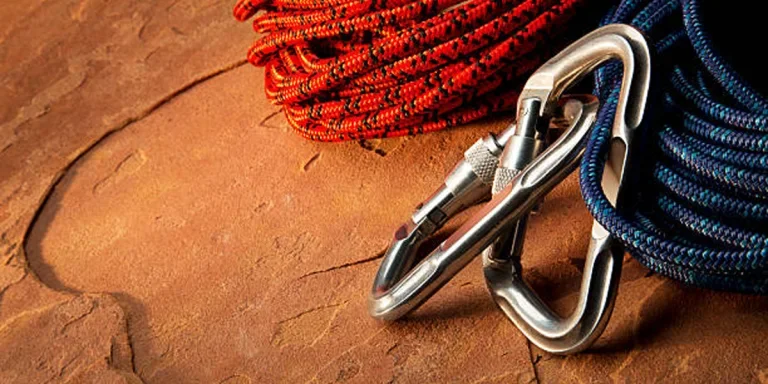Choosing the best carabiners for climbing is a big task for both seasonal and beginner climbers. Carabiners are a simple yet essential piece of climbing equipment that allows climbers to safely climb up the rock face.
Consumers will be looking at features such as materials, mechanisms, weight, and intended use when selecting the best carabiners for them. Keep reading to learn all about carabiners for climbing.
Table of Contents
Global market value of climbing carabiners
Best carabiners for climbing
Conclusion
Global market value of climbing carabiners

Climbing is a popular adventure and recreational sport, but it can be dangerous without the right equipment. With an increase in awareness of safety standards as well as new innovations in designs and materials, carabiners have become more modern and easier to use for people of all climbing abilities.

In 2023, the global market value of carabiners reached USD 158.80 million. Between 2024 and 2030, that number is expected to grow by a compound annual growth rate (CAGR) of 5.2%. This would bring the total market value to above USD 170 million.
Best carabiners for climbing

There are a lot of carabiners available in today’s market, so consumers may feel overwhelmed when choosing the best one for them. Many of these carabiners aren’t suitable for holding body weight while climbing, but they can be used to hold onto climbing gear or other accessories. There are three main types of carabiners for climbing that will be looked at.

According to Google Ads, “carabiners” has an average monthly search volume of 246,000. Searches are consistent throughout the year, sitting between 201,000 and 246,000 searches per month, with the exception of in November, when searches reach 301,000.
When looking at the different types of carabiners, “carabiner clip” comes out on top with 40 500 monthly searches, followed by “locking carabiner” with 3,600 searches and “non-locking carabiner” with 170 searches. Keep reading to learn about the best carabiners for climbing.
Carabiner clip

The carabiner clip is often referred to as a non-load-bearing carabiner and is used to attach accessories to the climber or as a decorative keyring. This type of carabiner isn’t designed to bear the weight of a climber and is used for non-essential tasks. The carabiner clip is available in a wide variety of shapes and colors, which makes it appealing to buyers and allows it to stand out among other carabiners.
This is one of the best carabiners for organizing accessories or hanging up gear, such as shoes and water bottles, while people are climbing. They’re made of a lightweight material, such as aluminum, so minimal weight is added to the climber’s gear. The choice of style depends on the individual, but they are available in locking, non-locking, or snap gate designs.

The carabiner clip has a smaller gate opening than other carabiners since they’re not designed to bear heavy loads. This is ideal for tasks such as attaching small items to bags or organizing gear where larger carabiners would be too bulky. Using this carabiner for climbing tasks can seriously put the climber at risk, as it doesn’t meet the safety standards of a heavy-duty carabiner for climbing.
Locking carabiner

The locking carabiner is used in situations where climbers need to ensure their safety. Activities such as belaying, rappelling, abseiling, and glacier climbing are all examples of when the locking carabiner would be used to the greatest advantage. The locking mechanism is designed to prevent the gate from accidentally opening in critical situations.
There are three main types of locking mechanisms to consider. A screw gate will have the gate of the carabiner attached to a threaded sleeve, which has to be manually rotated for the gate to be pushed open. It then needs to be screwed shut to prevent it from opening while the person is climbing.

A twist lock mechanism involves twisting a barrel to open or close the carabiner, and it is popular in climbing situations where speed is essential. There’s also the auto-locking carabiner, which has a spring-loaded gate that automatically closes and locks when it’s released. All types of locking carabiners are made from high-strength steel or aluminum that can withstand various climbing environments.
The locking carabiner is designed to withstand heavy loads and forces, so they are available in different weights and sizes depending on the needs of the climber as well as the rope diameter and attachment points.
Non-locking carabiner

The non-locking carabiner, also known as a snap gate carabiner, is predominantly used in quickdraws as it has no locking mechanism on the gate. It’s easy to attach to an anchor point or hook up climbing gear to a harness, and it can be useful for connecting ropes to protection points.
It’s not as durable as a locking carabiner, but it’s still made of a strong material, such as aluminum alloy, which is known for being lightweight. This type of carabiner is designed to withstand forces encountered while climbing but shouldn’t be used in critical situations where the gate needs to remain locked.

The non-locking carabiner is available in different styles. The standard design features either a straight gate, which is used to prevent the carabiner from getting stuck on a bolt, or a bent gate, which simplifies the quickdraw process by guiding the rope in. The wire gate carabiner can be used in extreme conditions without freezing up; it has a thinner gate that makes it lighter and can be used in wet conditions.
The nose design of the carabiner is also important. The keylock nose is smooth, with no hook at the closure point, which minimizes the risk of it snagging and the gate opening. This option is available in locking and non-locking carabiners and is used for sport and aid climbing.
The hooked nose has a hook at the gate and is designed to hold the rope in place when the carabiner is being loaded in situations such as rappelling and belaying. The notched nose has a small indentation at the gate, providing additional security for rigging and belaying. Both of these options are commonly found in locking carabiners rather than non-locking carabiners.
Conclusion

Choosing the best carabiners for climbing is crucial to ensuring the safety of the climber. There are three main versions of carabiners available, and each of these has different features that are better suited to specific climbing conditions. New technologies are constantly emerging and being incorporated into climbing carabiners to make them even more efficient and safe.




